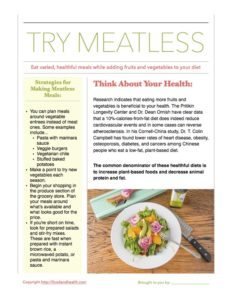Meatless Meals and Your Health
Research indicates that eating more fruits and vegetables is beneficial to your health. The Pritikin Longevity Center and Dr. Dean Ornish have clear data that a 10%-calories-from-fat diet does indeed reduce cardiovascular events and in some cases can reverse atherosclerosis. In his Cornell-China study, Dr. T. Colin Campbell has found lower rates of heart disease, obesity, osteoporosis, diabetes, and cancers (breast and colon) among Chinese people who eat a low-fat, plant-based diet.The common denominator of these healthful diets is to increase plant-based foods and decrease animal protein and fat.Phytochemicals found in fruits and vegetables help avert cancer; their fiber lowers LDL cholesterol and maintains well-being of the intestinal tract. Meat contains saturated fat, which raises cholesterol levels; animal protein has adverse effects such as releasing carcinogens upon high-temperature cooking (such as grilling) and causing loss of calcium due to high amounts of amino sulfur acids.While most experts recommend eating more fruits and vegetables, Dr. Jay Kenney, Ph.D., R.D., FACN, of the Pritikin Longevity Center doesn't advocate a strict vegetarian (vegan) diet. He says it is difficult to get all necessary nutrients from a strictly vegan diet (citing B-12 as one of them); furthermore, most people would find it too depriving. Meatless meals are beneficial, though, and he encourages people to eat them more often in order to increase amounts of fruits and vegetables in their diets while decreasing the amounts of animal products, fat and salt.Here are some tips for increasing your plant-based food sources:
- Scientific Board of Advisor members, Bernie and Dora Jacobs eat meatless meals at home and enjoy fish and poultry meals whenever they go out to restaurants, parties, or friends’ houses.
- Elaine Kvitka, MS, RD, and Robyn DeBell, MS, RD, eat vegetarian meals during the day and enjoy meals with a small amount of fish, lean meat, or poultry at night.
- You can plan meals around vegetable entrees instead of meat ones. Some examples include...
- Pasta with marinara sauce
- Veggie burgers
- Vegetarian chile
- Stuffed baked potatoes
- Make a point to try new vegetables each season. By increasing your repertoire of fruits and vegetables, you will incorporate more plant-based foods into your diet.
- Begin your shopping in the produce section of the grocery store. Plan your meals around what’s available and what looks good for the price.
- If you're short on time, look for prepared salads and stir-fry mixes. These are fast when prepared with instant brown rice, a microwaved potato, or pasta and marinara sauce.
Sources: Dr. Jay Kenney, Ph.D., R.D., FACN, Pritikin Longevity Center, Nutrition Advocate Newsletter and Cornell-China-Oxford Project, Consumer Reports on HealthAnd here are some tips for going meatless in restaurants:“Just because a menu item is vegetarian doesn’t mean it’s low in fat,” states Judy Peters of Heart Smart International®, a company that calculates and approves healthful items for restaurants. Vegetarian items are often loaded with oil, mayonnaise, and high-fat dairy items.The important thing to remember is to ask questions and make substitutions. Here are a few common items with specific requests given in parenthesis to ensure a delicious lowfat meal:
- Vegetarian Pizza (without cheese, Parmesan on the side)
- Pasta (without oil or cheese, Parmesan on the side)
- Vegetarian Sandwich (without cheese, ask for mustard and/or nonfat salad dressing )
- Baked Potatoes (with nonfat sour cream, yogurt or salsa)
- Salads (with vinegar or nonfat salad dressing)
- Stir-fries, Fajitas, and Sautéed items (specify using broth instead of oil to cook)
Finally, here are some tips for increasing the number of fruits and vegetables in your eating pattern:
- Sandwiches are the quickest and easiest meals to prepare with more vegetables.
- All types of greens from spinach to red leaf lettuce can be used.
- Try fresh tomatoes, mushrooms and bell peppers for good flavor.
- Cucumbers and carrot slices add a crunchy texture while onions and chiles add a bite.
- For condiments, consider your favorite nonfat Italian dressing, whole grain mustard or nonfat sour cream.
- Add fruit to your breakfast cereal!
- Strawberries, bananas, and fresh peaches are all great options.
- Birchermuesli is made with raw oats, skim milk, yogurt, and a medley of your favorite sliced fruits such as apples, pears, oranges and bananas.
- Pasta is the perfect canvas for a variety of vegetables.
- A simple pasta primavera dish with low-sodium store-bought marinara sauce can be quickly spruced up with all kinds of fresh vegetables.
- A few ideas might include broccoli, mushrooms, eggplant, yellow squash, zucchini, bell peppers and onions.
- The vegetables can be cooked right in the marinara sauce while you heat it up- add them in the order that they cook.
- Salads, especially side salads, add variety, color, flavor and texture to meals.
- Quick slaws can be made with shredded cabbage and your favorite nonfat dressing (such as poppy seed, mustard or nonfat vinaigrette).
- Tossed green salads can be awakened with warm dressings by heating vegetables such as mushrooms, bell peppers, and onions with nonfat Italian dressing.
- Toppings might include bagel chips, freshly ground black pepper, an additional sprinkling of balsamic vinegar, or Parmesan cheese.
Spread the word about these fantastic tips and tricks with a brand-new PDF handout! Don't miss these great fruit and vegetable resources either![shopify embed_type="product" shop="nutrition-education-store.myshopify.com" product_handle="dvd-building-a-plant-based-eating-pattern-vegetables" show="all"][shopify embed_type="product" shop="nutrition-education-store.myshopify.com" product_handle="plant-power-poster-for-fruit-and-vegetable-promotion" show="all"][shopify embed_type="product" shop="nutrition-education-store.myshopify.com" product_handle="vegetarian-and-plant-based-diet-for-better-health-powerpoint" show="all"]
Don't miss these great fruit and vegetable resources either![shopify embed_type="product" shop="nutrition-education-store.myshopify.com" product_handle="dvd-building-a-plant-based-eating-pattern-vegetables" show="all"][shopify embed_type="product" shop="nutrition-education-store.myshopify.com" product_handle="plant-power-poster-for-fruit-and-vegetable-promotion" show="all"][shopify embed_type="product" shop="nutrition-education-store.myshopify.com" product_handle="vegetarian-and-plant-based-diet-for-better-health-powerpoint" show="all"]


